Table of contents
What is Predictive Analytics?
7 Ways Predictive Analytics Powers Your eCommerce App’s Success
How AI Fuels Predictive Analytics
Key Metrics to Track the Impact of Predictive Analytics
Roadmap to Implement Predictive Analytics in Your eCommerce App
Challenges and Considerations During Implementation
Conclusion: Your App’s Smartest Sales Tool
Frequently Asked Questions (FAQs)
What if your eCommerce app could read your customers’ minds? Businesses today are rapidly shifting from merely reacting to customer behavior to proactively anticipating it. This fundamental change, driven by AI, is revolutionizing the way eCommerce apps operate.
A sleek app is no longer enough. To truly win, you need to understand your customers deeply, predict their next move, and offer experiences so personalized they inspire unwavering loyalty. This is precisely where predictive analytics steps in, unlocking unprecedented potential for your business.
In this article, we’ll delve into how AI forecasts customer behavior, personalizes experiences, and optimizes every aspect of your eCommerce website and app development services, ultimately enhancing sales and building stronger customer relationships.
But first, the basics.
What is Predictive Analytics?
Simply put, predictive analytics uses historical data, statistical algorithms, and machine learning techniques to forecast future outcomes. It’s like a super-powered crystal ball for your eCommerce app. By analyzing past purchase history, browsing patterns, demographics, and even social media activity, AI can identify trends and predict your customer’s next move.
Shopify website development services, for example, utilizes predictive analytics with its customer segmentation tools, enabling businesses to personalize email campaigns and offer targeted discounts to their customers. This goes beyond basic personalization; it’s about anticipating individual needs and preferences.
7 Ways Predictive Analytics Powers Your eCommerce App’s Success
01 | Hyper-Personalized Recommendations
Predictive analytics helps your app suggest products that feel like they’re reading your customer’s mind. AI analyzes past purchases, browsing history, wish lists, and similar customer behavior to predict what customers are most likely to buy next.
- How it works: If a customer buys running shoes, AI might recommend moisture-wicking socks or running apparel based on what other shoe buyers usually purchase.
- Sales Impact: Personalized recommendations are a revenue powerhouse. Statista reports that 35% of Amazon’s revenue is directly from its recommendation engine.
02 | Dynamic Pricing & Promotions
Forget fixed prices. Predictive analytics enables your app to dynamically adjust product prices and promotions in real time, finding the optimal price point for maximum sales or profit.
- How it works: AI considers demand, competitor pricing, inventory levels, time of day, and even individual customer browsing patterns to predict the optimal price that encourages a purchase.
- Example: AI might subtly increase rain gear prices during a sudden downpour or suggest a personalized flash sale for a slow-moving item to customers predicted to respond to discounts.
- Sales Impact: According to Deloitte, dynamic pricing strategies can lead to revenue increases of 5-10%.
03 | Inventory Optimization and Demand Forecasting
Predictive analytics takes the guesswork out of inventory management, helping you avoid costly overstocking and missed sales from running out of popular items.
- How it works: AI analyzes historical sales data, seasonal trends, marketing plans, and external factors to predict future demand for specific products accurately.
- Example: Before major holidays, AI can predict surges in demand for specific products, letting you order precisely the right stock weeks in advance, preventing both stockouts and excess inventory.
- Sales Impact: Accurate demand forecasting can reduce inventory costs by 10-40% and prevent lost sales due to out-of-stock items, according to KPMG.
04 | Fraud Detection
As online transactions grow, so does the risk of fraud. Predictive analytics acts as your app’s indispensable security guard.
- How it works: AI continuously analyzes transaction patterns, IP addresses, device types, and payment methods to identify anomalies and predict the likelihood of fraud in real time.
- Example: If a user makes multiple high-value purchases from different IP addresses with a new credit card, AI can flag or block the transaction, preventing financial loss.
- Sales Impact: Forbes reports that proactive fraud detection can save businesses billions of dollars annually in chargebacks and lost merchandise.
05 | Customer Churn Prediction and Retention
It’s far more cost-effective to retain existing customers than to acquire new ones. Predictive analytics helps you keep your most valuable customers.
- How it works: AI analyzes customer engagement (app usage, purchase frequency, and support interactions) to identify patterns that indicate a customer may be at risk of leaving. It flags them as “at-risk.”
- Example: If a loyal customer’s app usage suddenly drops, AI can trigger a personalized retention campaign, like a special discount or a “we miss you” message with new product highlights.
- Sales Impact: Reducing churn by just 5% can increase profits by 25% to 95%, according to a Harvard Business Review study.
06 | Optimized Marketing Campaigns
Predictive analytics transforms generic marketing into highly targeted campaigns.
- How it works: AI segments your audience based on predicted future behavior (e.g., predicted next purchase, likelihood to respond to discounts). This ensures the right message reaches the right person at the right time.
- Example: AI might identify users likely to buy smart home devices and send them a targeted ad for new products rather than a general promotion.
- Sales Impact: McKinsey reports that personalized marketing driven by AI can lead to 5-8x the ROI on marketing spend and lift sales by 10% or more.
07 | Predictive Customer Service
Elevate customer satisfaction and reduce support costs by anticipating needs and issues.
- How it works: AI analyzes customer behavior, common pain points, and reviews to predict when a customer might need help.
- Example: If AI detects a user repeatedly viewing a product’s return policy, it might proactively send them an FAQ, a tutorial video, or offer a live chat connection before they get frustrated.
- Sales Impact: Proactive customer service enhances satisfaction, directly influencing loyalty and repeat business. According to PwC, 89% of consumers are likely to switch to a competitor after experiencing poor customer service.
Read More - Agentic Chatbots: Empowering AI with Tools and Reasoning
How AI Fuels Predictive Analytics
AI isn’t just one thing; it’s a collection of technologies working together. In predictive analytics for eCommerce, two key components are:
- Machine Learning (ML): ML algorithms learn from data without being explicitly programmed. They identify patterns and relationships that humans might miss.
- Deep Learning: A more advanced form of machine learning development, deep learning utilizes neural networks to analyze complex data, such as images and natural language.
These technologies enable eCommerce apps to:
- Process Vast Datasets: AI can analyze massive amounts of customer data quickly and efficiently.
- Recognize Complex Patterns: AI identifies subtle patterns in customer behavior that indicate future actions.
- Adapt and Improve Over Time: ML algorithms continuously learn from new data, making predictions more accurate over time.
Key Metrics to Track the Impact of Predictive Analytics
It’s not enough to implement predictive analytics; you need to track its impact to ensure it’s truly boosting your bottom line. Measuring key metrics helps you refine your AI models, optimize campaigns, and demonstrate tangible ROI.
Essential Metrics for Predictive Analytics Success
| Metric | What it Means |
| Customer Acquisition Cost (CAC) | The total marketing and sales expenses you incur to gain a new customer. |
| Return on Ad Spend (ROAS) | The revenue you generate for each dollar you spend on advertising. |
| Customer Lifetime Value (CLV) | The total revenue you expect to generate from a single customer account over their relationship. |
| Organic Conversion Rate | The percentage of visitors coming from organic search results who complete a desired action (e.g., make a purchase). |
| Brand Mentions/Sentiment | Tracking how often your brand is mentioned across various online platforms and the general tone (positive, negative, neutral) of those mentions. |
Roadmap to Implement Predictive Analytics in Your eCommerce App
- Define Your Goals: Start by clearly outlining what you want to achieve. Do you aim to boost sales by a specific percentage, reduce customer churn, or optimize inventory levels? Clear goals will drive your efforts.
- Data Collection and Preparation: This is a fundamental step. Ensure you have clean, comprehensive historical data from your app, including purchases, Browse activity, clicks, demographics, and support interactions. This often involves integrating data from various platforms, such as your CRM Development Services and ERP.
- Choose the Right Tools and Partners: You’ll need resources. Consider whether you’ll leverage in-house data scientists, utilize powerful AI/ML Platforms (like Google Cloud AI Platform or AWS SageMaker), or engage expert partners like Brainvire to build custom models and integrate them into your existing app.
- Develop and Train Models: Select and train AI algorithms based on your goals. For example, classification models for churn prediction or regression models for demand forecasting will learn patterns from your historical data.
- Integration into Your App: Seamlessly integrate the predictive insights. This could involve real-time API calls for dynamic pricing, automated triggers for marketing campaigns, or dashboards for inventory management and control.
- Test, Refine, Iterate: Predictive models require continuous improvement. Regularly monitor, test (including A/B testing), and retrain your models with new data to enhance accuracy and adapt to evolving customer behaviors and market trends.
Challenges and Considerations During Implementation
While the benefits are immense, implementing predictive analytics isn’t without its hurdles. Be prepared for these key considerations:
- Data Quality and Volume: Your AI models are only as good as the data they’re fed. Ensuring clean, relevant, and sufficient data is crucial and often a significant challenge.
- Complexity and Expertise: Building and maintaining sophisticated AI models demands specialized skills in data science, artificial Intelligence development services and IT infrastructure.
- Privacy Concerns: Handling vast amounts of customer data requires strict adherence to privacy regulations (like GDPR and CCPA). Transparency regarding data usage is crucial for establishing customer trust.
- Bias in Data: AI models can unintentionally learn and amplify biases from historical data, potentially leading to unfair or inaccurate predictions. Careful monitoring and ethical AI development are critical.
- Integration Challenges: Seamlessly integrating predictive insights into existing app functionalities and other business systems can be a complex task.
- Cost: The initial investment in data infrastructure, AI platforms, and expert talent can be substantial, though the long-term ROI typically outweighs this.
Read More - Creating a Simple Chatbot: Shaping the Future of Conversational AI
Conclusion: Your App’s Smartest Sales Tool
The future of eCommerce isn’t just about selling; it’s about anticipating. Predictive analytics, powered by AI, is rapidly becoming a necessity for any eCommerce app aiming for growth and customer loyalty. By leveraging insights hidden in your data, you can move beyond guesswork into proactive strategies that truly understand and cater to customer needs.
From hyper-personalized experiences and optimized inventory to smarter pricing and enhanced fraud detection, AI-driven prediction is transforming every facet of the eCommerce app. It helps you deliver relevant, timely, and delightful interactions that not only boost sales today but also build lasting relationships.
The ability to anticipate is your eCommerce app’s smartest sales tool.
Frequently Asked Questions (FAQs)
What does “predictive analytics” mean for my eCommerce app?
Predictive analytics for your eCommerce app means using customer data (such as past purchases, browsing history, and app usage) and AI to guess what customers might do next. This could involve predicting which products they’ll want when they might stop buying or even identifying which transactions might be fraudulent. It helps your app act smarter and proactively.
How does AI actually help predict customer needs in an app?
AI, specifically machine learning, analyzes vast amounts of data very quickly to find hidden patterns in customer behavior. It learns from past actions to predict future ones. So, if many customers who bought Product A also bought Product B, AI learns that pattern and can suggest Product B to new buyers of Product A.
Will predictive analytics make my app’s recommendations better?
Absolutely! Making your app’s recommendations better is one of the most visible benefits of predictive analytics. AI-powered recommendations are highly personalized because they consider a huge range of data unique to each user. This leads to suggestions that are much more relevant and likely to result in a purchase, boosting your app’s sales.
Can predictive analytics help me manage my product inventory?
Yes, predictive analytics can help you manage your product inventory very well. It can forecast future demand for specific products by analyzing sales history, seasonal trends, and external factors such as upcoming holidays or marketing campaigns. This helps you stock the right amount of products, avoiding both costly overstocking and missed sales from running out of popular items.
Is implementing predictive analytics expensive for an eCommerce app?
The initial investment in predictive analytics can vary, depending on the complexity and scale. It involves collecting and cleaning data, choosing specialized AI tools or platforms, and potentially hiring data experts or partnering with a firm like Brainvire. However, the long-term benefits of increased sales, reduced costs, and improved customer loyalty often provide a significant return on this investment.
Related Articles
Digital Transformation
Beyond the Click: Leveraging Customer Journey Analytics with Adobe Analytics for Deeper Insights
Digital Transformation
Orchestrating Seamless Customer Journeys: The Power of Adobe Journey Optimizer (AJO) in Real-Time
Digital Transformation
Turning Data into Dollars: How to Use SEO Analytics to Boost Your Sales







